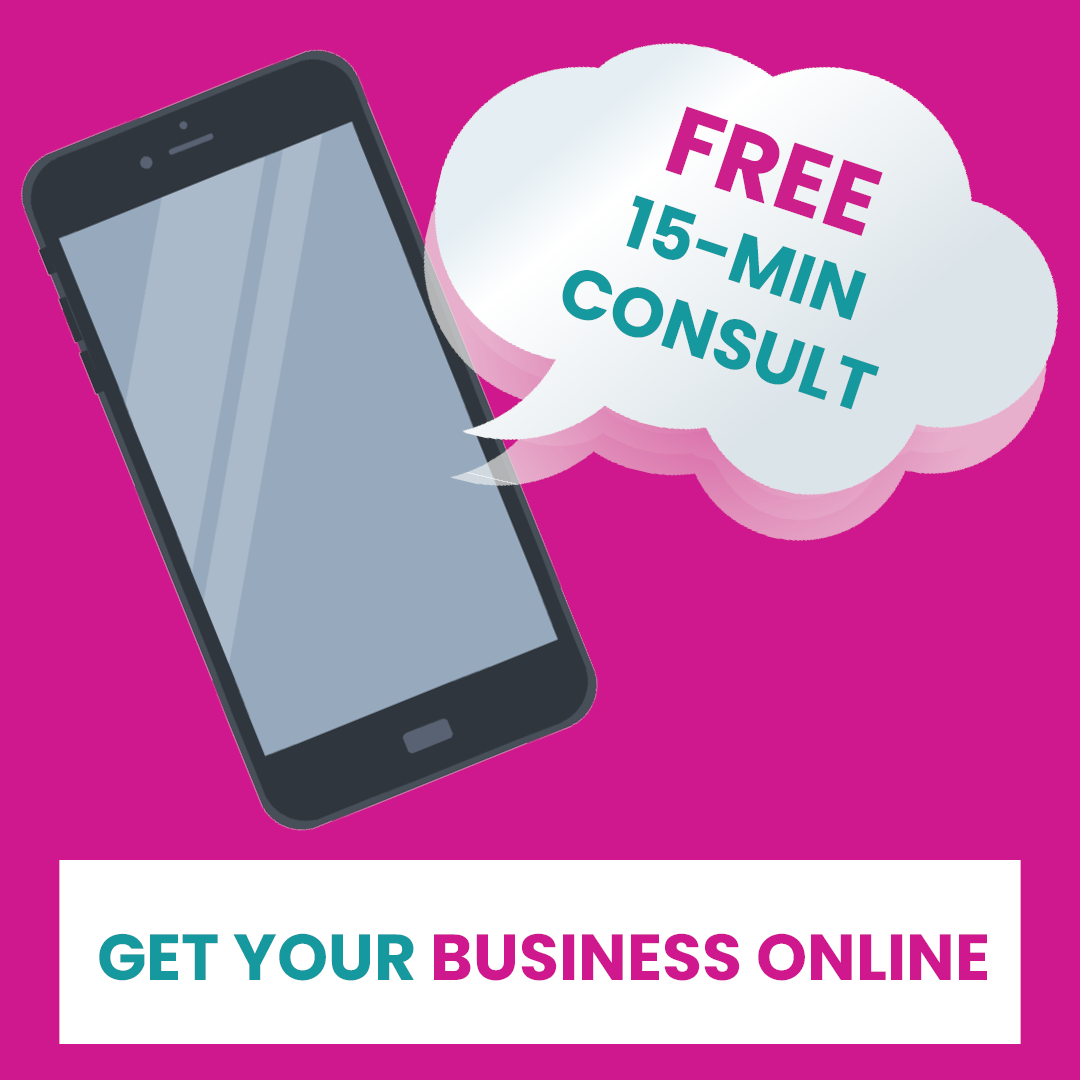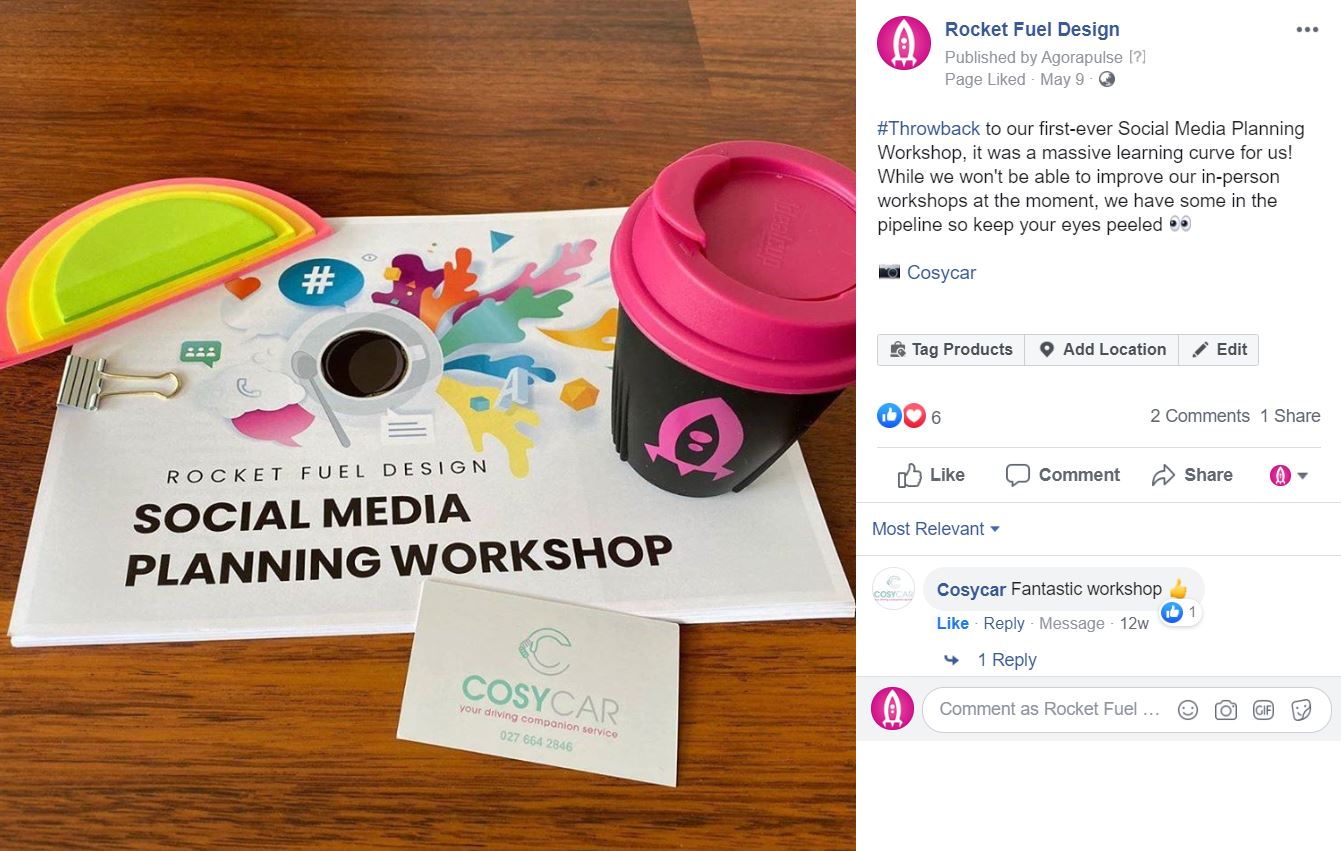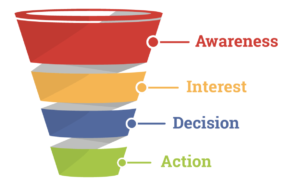The post The Importance Of Consistency With Social Media appeared first on Rocket Fuel Design.
]]>We get it, life gets busy and business gets hectic. But you wouldn’t skip on paying a bill so why would you skip on posting to your social media platforms?
Consistency is one of the key factors in running successful social media platforms. The number one thing you hear from successful YouTubers is to be consistent but what does that mean? When we talk about consistency we are not just talking about consistent posting but consistence voice and branding too!
Why Constance posting?
Building Relationships
Like building any relationship, being there for someone, being ‘predictable’ is important. It’s much the same when it comes to building a relationship with your audience and customers on social media.
Being ghosted and being spammed doesn’t go well in any relationship! So be consistent, every day post, 3 times a week or even just once a week is so much better than being showered with promotional posts when you’re feeling desperate or need to make that sale.
Find a balance of what works for you and your business both in the busy times and not so busy times. Developing a content schedule or always have evergreen content ready for those stressful weeks is a godsend.
The Algorithm
All social media platforms have their own way do doing things when it comes to their algorithms and it changes all the time [way to keep us social media managers on our toes!]. Which makes it tough for us to give you an in-depth understanding of what you should do [feel free to book in a FREE 15 min consultation with Lainey to talk further about your socials here].
A general rule of thumb is – the more you post the more engagement you get which helps to boost your future posts [within reason of course]. How does this work? Well, social media platforms aim to keep their users on their platform as long as possible. They want to show their users content that keeps them engaged and using the app for longer. So the more they intact with your content through clicks, reactions/likes and comments the more likely your content will appear on their newsfeeds.
What does Consistency Look like on Social Media?
The Content
The type of content you post is so important. You want to share content that is in line with your business, relatable and adds value. When we say you should have consistent content we don’t mean the same content themes over and over again. It is important to post a variety of content, but that variety of content has to be in line with your business. Being a design and Marketing company it makes little sense for us to post about fashion, but if we posted about the changes in fashion on social media it is more in line with what our business does.
For example on Rocket Fuel Design’s Instagram, we follow a grid theme that keeps our content looking consistent but allows us to change it up and keep some variety in what we post.
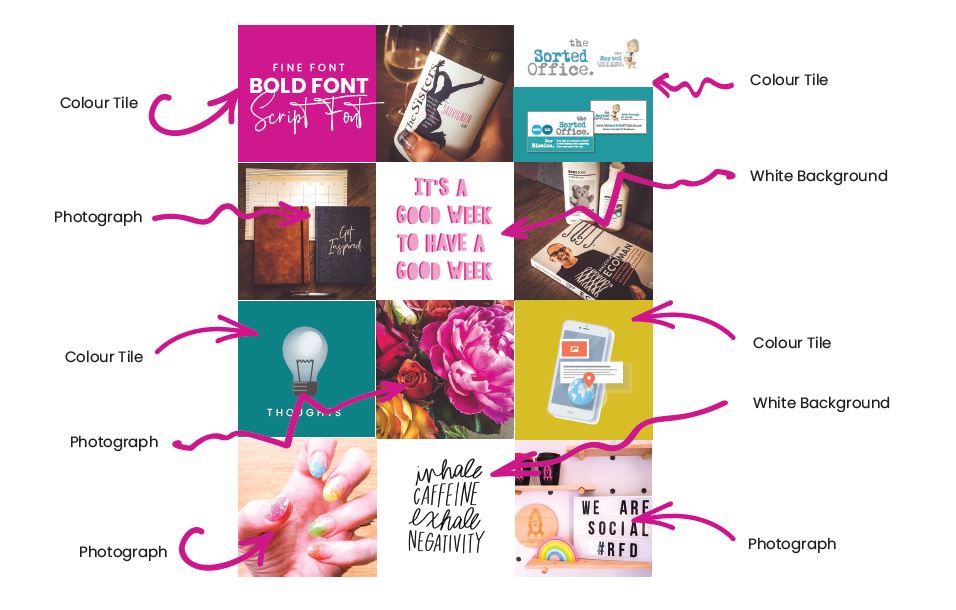
If your content is all over the place and has nothing to do with your offering you are guaranteed to lose followers because they are not getting what they thought they came for. So stay true to what you do and add value to your audience. If you want to know more about how to find content for your social media platforms checks out our blog – Guide to curating content for your social media.
Constant Brand Voice:
First, what is a brand voice? A Brand voice is the distinct personality, words, phrases, symbols etc. that you business uses.
For example, at RFD you can expect to see consistency on the way we display our brand name, our acceptable swearing, the emojis and the that we use. Here are some of the examples of our brand voice in our marketing branding guide:
 Having a consistent brand voice is important so you know who/what you’re dealing with. If you had grown up with your grandmother your whole life with an English accent and a very ‘proper’ way of speaking and then suddenly she is speaking slang you would feel quite confused, right?
Having a consistent brand voice is important so you know who/what you’re dealing with. If you had grown up with your grandmother your whole life with an English accent and a very ‘proper’ way of speaking and then suddenly she is speaking slang you would feel quite confused, right?
Having your own brand voice guide, auditing yourself and making sure your voice suits your personas and audience is important so you can make sure you’re speaking with consistency and connecting with your audience.
Constance Branding:
Keep your branding looking similar across all your social media platforms. This doesn’t mean they have to look exactly the same, but similar use of colours, fonts, logos is perfect. We highly suggest adapting to not just the sizing of each individual platform, but to their best practices too. This will help to develop brand recognition, loyalty and trust. Across all our socials and website we use the same styles of colour and logos throughout.
Producing a style guide is a great way to make sure your whole team knows which colours and logos they can use when producing content.
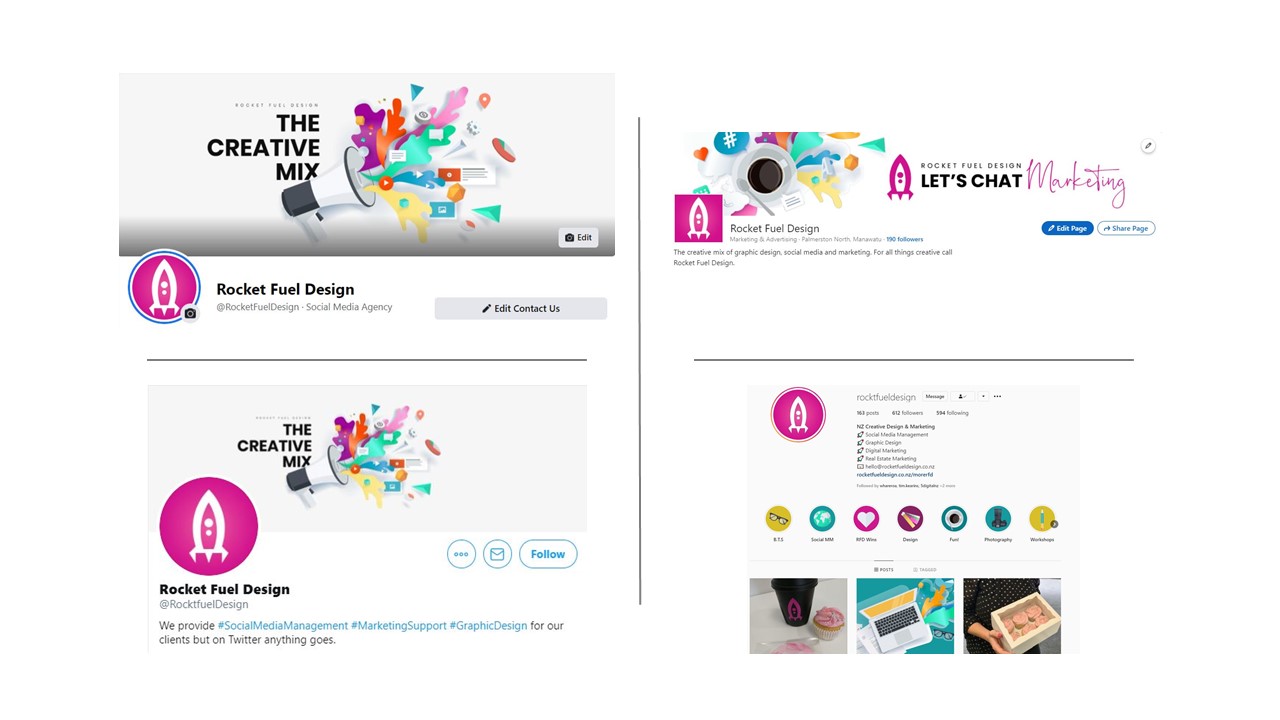
Sometimes, we compare social media to the yellow pages, people often look up your social media page to check if your business is still operating. There are billions of websites out there and a lot of them are owned by inactive businesses. Posting consistently on your socials helps to demonstrate to potential and past clients that you are in fact relevant and in work, not to mention all the great offerings you have that they might have missed on your website.
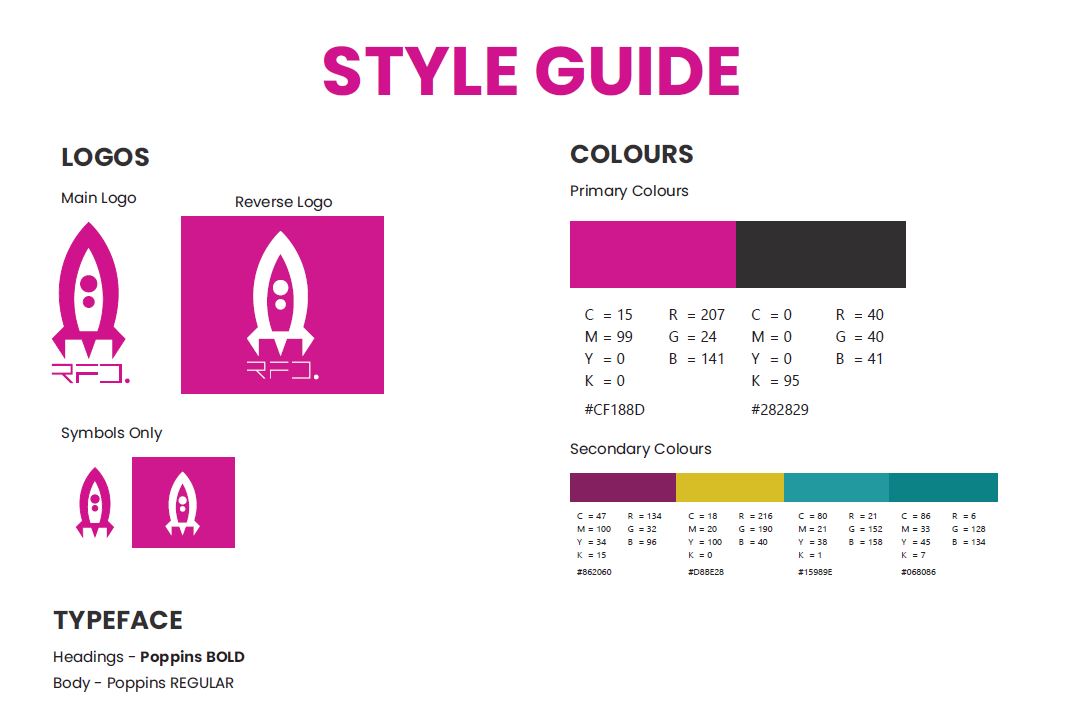
Consistency is key when doing anything in life – yes we sound like your parents – but it is so true especially with social media platforms. The best way to stay consistent is to plan and strategise your content and branding. At Rocket Fuel Design we have a range of Social Media Workshops to help you come out with real and practical tips and tricks for your social media that you can apply straight away.
So when it comes to having a successful social media presence it pays to regularly post to build relationships and get the best of the algorithms. Keep in mind the content you share, your brand voice and style so that your audience gets the best possible experience with your business online.
Got any questions about your businesses marketing, book a FREE 15-minute No-obligation Consultation with Rocket Fuel Design Founder, Lainey.
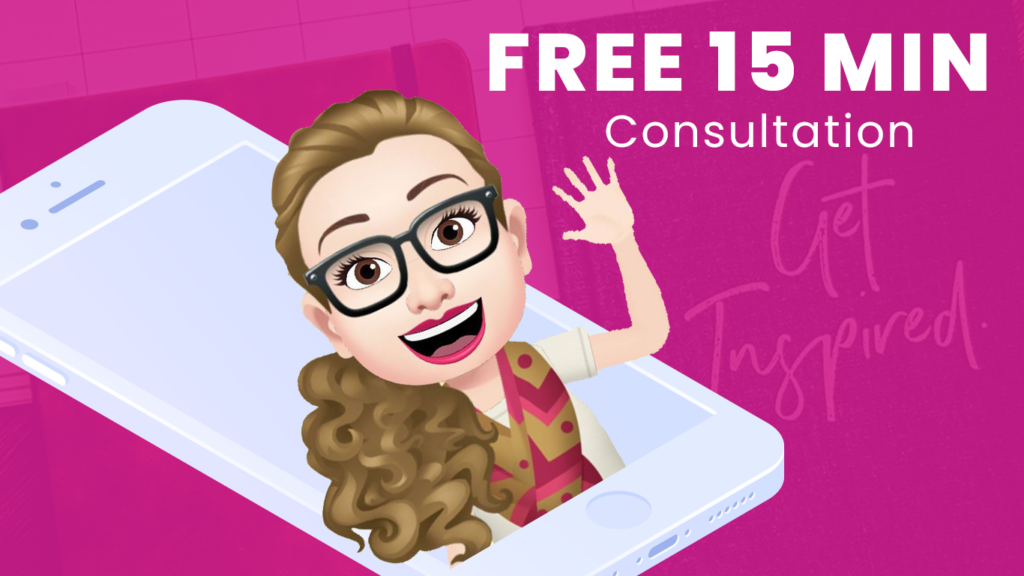
The post The Importance Of Consistency With Social Media appeared first on Rocket Fuel Design.
]]>The post Paid verse Organic Social Media Posts appeared first on Rocket Fuel Design.
]]>
Are all the best things in life free? Or does it pay to spend a little to get just a bit more? When it comes to managing a social media page it can be hard to know what exactly is the right move for your brand; go organic or go paid.
In general, social media and inbound marketing are known for their more ‘organic’ approach to marketing. Where a brands offerings or values are not ‘pushed upon an audience’ like outbound marketing, but instead are sought out and consumed but audiences with value-adding or entertaining attributes. But today with an abundance of business on social media sites advertisements have been introduced.
What is paid and organic social media?
Paid
Paid social media include boosted and targeted advertisements, they will show up in users timelines and other placements like Messenger as advertisements or sponsored posts. Paid advertisements not only get your content in front of your follows but allow your brand to reach people who do not follow you too.
Paid influencer marketing a whole other kettle of fish altogether that we will not be going into on this blog – but keep your eyes out!
Organic
Organic social media post are not paid for and are essentially ‘free’ to post on social media platforms ( free not counting your time). These posts show up in the feeds of people who have chosen to follow your brand. However, if your followers choice to share, engage or like/react to your post may organically be shown to people would are not your followers.
Pros and Cons of paid and organic social media:
Organic
- Pro: It’s ‘free’ well if you don’t count your time maintaining it
- Pro: nurtures a more organic feeling connection between brand and audience
- Con: time-consuming
- Con: algorithm hard to understand – changes often
- Cons: only a small percentage of your followers will see your organic posts – ADD NZ percentage of followers seeing posts
As the algorithms change and the percentage of followers seeing organic posting is declining it’s getting harder than ever to get your content seen! That’s why paid Social media isn’t all too bad when it comes to
Paid
- Pro: Target specific people
- Pro: Budget adaptable
- Pro: Can see faster results
- Con: Might not see ROI
- Cons: Understanding your target audience and advertising platform
- Cons: Possibly more time – mores analytics and changes to get better ROI
Tips for Paid and Organic Social Media
Paid
- Boost best organic content
- Don’t feel like you have to advertise all promotions, sometimes the best success comes from producing great content your audience wants to share
- Play around and adapt your advertisements based on data and results. A/B testing a popular word among marketers for a reason, it helps you improve your ROI and create better advertisements.
- Keep your brands KPI in mind when advertising
Organic
- Post consistently
- Post strategically
- Post a range of types and forms of content
- Think am I adding value?
- Respond to all comments and messages
- Encourage engagement and interaction
So What Should You Use Paid or Organic?
Sorry, no simple answer here!
Overall we highly suggest using a range of organic and paid media when managing your brand social media page. We believe that although great consistent content can attract new audiences, paid marketing just does it so much faster for less effort. So should you pay for every content you post on social media, the short answer is no way!
Use paid social media posts when you are looking for to generate new leads, want to raise brand awareness, promote a deal, or drive conversions. You wouldn’t put just anything on a billboard so be selective and think strategically about the content you chose to push.
Use Organic social media posts to build on creating great connections/relationships with existing followers, provide customer services and build awareness about your brand’s offerings.
The post Paid verse Organic Social Media Posts appeared first on Rocket Fuel Design.
]]>The post 50+ Social Media Terms You Should Know appeared first on Rocket Fuel Design.
]]>Like any other field of work, working in social media comes with a whole set of jargon you need to understand. In alphabetical order here’s our list of social media-related lingo you should know.
A
- A/B Testing
A/B testing is used to test the differences between two variants, A and B. Using A/B testing means you can work out what factors get you the best results. For example the time for posting for a food restaurant, A: 12.00 PM B: 11.00 AM which performs the best. From there you can keep testing times against each other until you find the best result.
- Algorithm
A process or set of rules to calculate and dispute curated content for users. For example, a social media platform will push content you interact with more often to the top of your newsfeed to keep you engaged for longer.
- Analytics
Your analytics is your stats and data. Analytics are an important part of managing a social media page as it gives you an indication of where your business is going. Unfortunately, your analytics will be displayed in different ways across social platforms, so take your time to understand your analytics and what each stat means.
B
- B2B
B2B stands for Business to Business. If you are a business that sells services or products to other businesses you are a B2B marketer. For example, we sell our service of design and social media management to other c, making us a B2B company.
- B2C
B2C stands form Business to Customer. If your business sells to people in general, for example, you sell day dresses you are a B2C business.
- Bio
A bio stands for a Biography which details describe facts about a person or business. While biographies in a traditional sense go in-depth about peoples experiences etc. a bio on social media tends to be short facts like education, work, or life events.
- Blog
A blog is a discussion, journal or information based content on a website. Blogs can be used to improve SEO scores, give audiences information and discuss ideas. For example, this right here is an information-based blog.
- Boost
A boosted post will optimize your post to increase engagement. When targeting with a boosted Facebook post you have three options; people who like your page, people who like your page and their Facebook friends, or targeted audience of your choice. While you can ‘target’ an audience, the ability to narrow target audiences down is very limited, check out our blog post on why we think you should Stop BoostingYour Facebook Posts.
C
- Canva
Canva is an online design platform which has loads of great templates form social media and more.
- Chatbot
A chatbot uses software to have an automated online conversation. Chatbots can help replace some human interactions, but we recommend thoroughly testing the user experience before launching.
- Clickbait
Clickbait is the act of using misleading/exaggerated headlines or imagery to lurer people to click onto your content [not cool].
- Content
When people talk about content in a social media context they don’t mean a sense of happiness or fulfilment. Content refers to the different style of posts you can use from status, images, videos, articles, stories and so forth. If you want to learn more about how to curate content for your social media pages make sure to check out our blog – Guide to Curating Content for Your Social Media
- CPL
Cost Per Lead [CPL] is the measurement used to show how cost-effective your marketing campaigns are and compare your costs to the number of new leads. Let’s say you are a beauty salon and you spent $100 on advertising, from your advertisement you gained 10 new booking requests then your CPL or cost per lead is $10. From there you can use this information to determine if your advertising was successful.
- CTR
CTR stands for Click Through Rate which is the ratio of clicks received on your ads per number of impressions.
- CTA
A Call To Action [CTA] is used to help prompt your audience immediately to do something i.e sign up for a newsletter, call you, get a quote. CTAs can be found in many different forms from copy, on imagery, buttons and more!
D
- Digital Marketing
Digital Marketing or online marketing refers to marketing components that use the internet and online digital technology to promote products. For example, social media is a digital marketing strategy, computers, mobile phones, emails are also digital marketing.
- Dark post
Dark posts are targeted ads on social media, they target audiences specifically for lead generation and conversion. The [ad] post is not on on the advertiser’s timeline and does not target their current followers, instead, they appear on the feeds of the targeted audiences, normally labelled as sponsored content.
- DM/PM
DM stands for Direct Message and PM personal/private message. To DM or PM means that the conversation or content shared can only be seen and accessed by the accounts in the chat.
E
- E-Commerce
E-Commerce stands for electronic or internet commerce, a good or service is sold/bought using the internet it is classified as E-Commerce. E-commerce stands for electronic or internet commerce and it is not just limited to B2C it includes C2C, C2B and so forth.
- Emoji
An Emoji is a small digital image or icon often use in text, which helps to express ideas and/or emotions.
- Engagement
Engagement is used to describe interactions on digital platforms such as social media and emails. The main types of engagement measured are clicks, reactions/likes, comments, shares, opens and private messages. These are often used as indicators of success, but we suggest not to get sucked into vanity metrics such as seeking lots of likes on content.
- Evergreen content
Evergreen content is content that does not become outdated, just like evergreen plants it retains its ‘greenness’/value year-round. Evergreen content can include helpful information about your product/services, quotes, testimonials, Q&A, facts and so forth.
F
- Feed
A feed or news feed is the data format used on social media platforms to provide people with frequently updated content.
- Filter
A Filter on social media, just like a filter on a camera changes the colourisation of images or videos. Some filters even change the way people physically look.
A filter is used to refine and personalise content seen by users through algorithms.
- Follower
A follower is a person or an account that want to like and want to see your content on their newsfeed.
G
- GIF
A GIF stands for Graphical Interchange Format, which is an image format that shows a series of images or soundless video that loops continuously without anyone having to press play. Like memes and emojis, GIFs are often used to express emotions and ideas.
H
- Handle or Username
A social media handle is your public username used to represent your account on social media. A handle follows an @ symbol. A handle allows another account to tag, reach out and communicate with you.
- Hashtag
A hashtag or # is a tag that allows users to connect content to a specific topic, event, theme or conversation. Hashtags can help improve your posts/accounts discovery/impressions, as when you click or follow a hashtag all social media content with that same hashtag will be shown. Well, not ALL but you get the gist.
I
- IGTV
Instagram TV [IGTV] allows people to share longer videos on Instagram.
- Impression
An impression is the number of times your content is displayed in front of a viewer. A viewer doesn’t have to engage with content to be counted as an impression. If your content is displayed on their feed this is counted as an impression.
- Inbound marketing
Inbound marketing is a way of reaching customers through content marketing, for example, social media, blogs, websites and branding. Inbound marketing aims to draw its audience, rather than push it on them [outbound], by providing valuable content and experiences in hope of creating a lead/customer.
- Influencer
An influencer is someone with the potential to affect the purchasing decisions of others—they have influence [Hence the name]. In marketing, we call this an opinion leader.
K
- KPI
A Key Performance Indicator [KPI] is used to measure business performance, it is used to evaluate how effectively an objective has been met by a business.
L
- Lead
A person who shows an interest in your product/service can be called a lead. A lead is someone/business that could become a potential customer. Leads are then guided down the marketing funnel to try to convert them to be a potential customer.
M
- Marketing Funnel
A marketing funnel is used as a visualisation queue for understanding the process of turning leads into customers. A Marketing Funnel aims to capture as many leads as possible and take them from the top of the funnel to the bottom where they would become a customer.
- Meme
A meme is a piece of content; image, video, piece of text, etc, that takes becomes viral—usually humorous in nature. This piece of content becomes a fad and is copied and shared rapidly by Internet users.
O
- Organic
Organic social media reach/growth that is happening naturally or without paid help.
P
- PPC
PPC stands for Pay Per Click, it is a term used when advertising online. This means you [the advertiser] will pay the publisher [Facebook, Google etc.] when the ad your displaying is clicked.
R
- Relevance Score
A relevance score is a calculation based on perceived positive and negative feedback an advertiser expects to receive from the ads targeted audience.
- Retargeting
Retargeting are advertisements used to remind audiences who have already interacted with your business about your offerings. You know the ones we mean, when you visit a website and all of a sudden you see their ads everywhere! That’s remarketing.
- ROI
A Return On Investment [ROI] is used to evaluate the results/returns a business receives from their one or more investments. The return on investment is evaluated against its cost, for example, if you spent $100 on advertising and got four sales valued at $75, your ROI on this ad spend would be $200. This doesn’t just have to be a monetary return.
S
- Share
A share or sharing is when another account shares your content to their own profile, to another page or person via messenger, email or twitter, embed to a page etc.
- Social Listening
Social Listening is the act of monitoring social media channels for mentions of your business, competitors, product etc.
- Social Proof
Social proof is where what you are saying is validated by others. Testimonials/reviews are an example of social proof.
- Stories
Stories are a collection of images and short videos posted to a social media platform, for example; Facebook, Snapchat or Instagram. Stories disappear after 24 hours unless saved/pinned. Filters, text, gifs and other effects can be added to stories.
T
- Tag
To tag or tagging is to engage with another profile; individual or business. You can tag people in videos comments, photos, posts etc.
- Target marketing
Target marketing is when marketing and resources are made more specific and aim to reach a specific group of customers. For example, this blog is targeted toward those new to social media.
- Traffic
Traffic refers to the movement of accounts coming to your platform; Facebook, Instagram, website etc.
- Trending Topic
A trending topic refers to subjects that experience a surge in popularity on a social media platform.
- Troll
To troll or trolling is the act of deliberately provoking others online [also not cool].
U
- UGC
User-Generated Content [UGC] is any content i.e videos, images, reviews etc., created by people, not the brand/business themselves.
V
- Vanity Metric
Vanity Metrics are stats that might look good on paper but don’t actually help you to achieve your business goals or guide future marketing endeavours. Don’t get caught up in vanity metrics!
- Viral
Just like a viral infection, going viral on social media means a piece of content or idea spreads or is shared by social media users.
- Vlogging
Vlogging stands for video blogging or video log. Normally vlogs are centred around the vloggers daily life or other topics they wish to discuss.
So there you go fifty-plus social media terms you need to know and understand when working with social media! If you are keen to learn more about what you should know when it comes to social media or marketing make sure to check out our blog – 5 things I learnt about marketing that every business owner needs to know.
When it comes to making decisions about your businesses marketing there can be a lot to think about or even options you haven’t thought about. Launch your business into the digital world with a FREE 15-minute no-obligation consultation with Rocket Fuel Design’s founder – Lainey.
The post 50+ Social Media Terms You Should Know appeared first on Rocket Fuel Design.
]]>The post Free Tools For Your Business 2020 appeared first on Rocket Fuel Design.
]]>There are many things we believe businesses owners should know when it comes to running a business. Often there are times in your business journey where you should pay for extra help, perhaps with your social media, but there are places where you can cut back and opt for something free or don’t go there at all.
When it comes to social media there are some great tools to help you create awesome content [without breaking the bank]. Here are some of our favs:
Content Creation:
- Canva – https://www.canva.com/
- Befunky – https://www.befunky.com/
- Snappa – https://snappa.com/
- Animaker – https://www.animaker.com/
Instagram:
- Inshot – http://www.inshot.com/
- Kirakira+ – http://kirakiraapp.com/
- Boomerang – Get it from your app store
- Snapseed – https://snapseed.online/
- Layout – Get it from your app store
- A Design Kit – https://acolorstory.com/a-design-kit/
- LifeLapses – https://www.lifelapseapp.com/
Content Holders:
Save the hassle of having to post items as soon as you see them or risk forgetting about them altogether. Using content holders means you can save content on the go and look at them easily later on!
Feedly – https://feedly.com/i/welcome
Pocket – https://app.getpocket.com/
Email:
Email marketing is a great way to deliver information to your audience, while there sure is an abundance of different EDM programs you can use, our personal favourite is Mailchimp!
- Mailchimp – https://mailchimp.com/
- Sendinblue – https://www.sendinblue.com/
- MailerLite – https://www.mailerlite.com/
Find Content:
- Google Alerts – https://www.google.co.nz/alerts
- Days Of The Year – https://www.daysoftheyear.com/
- Pinterest – https://www.pinterest.nz/
- Quotes – https://www.goodreads.com/quotes
- Unsplash – https://unsplash.com/
Photos:
With many social media platforms being so visually based it’s important to have lots of images for you to post. But with copyright laws and professional photos being so darn expensive sometimes your next best option is to find stock images that are free.
- Pexels – https://www.pexels.com/
- Unsplash- https://unsplash.com/
- Reshot – https://www.reshot.com/
- Pixabay – https://pixabay.com/
- Foodiefeed – https://www.foodiesfeed.com/
- CEDA Image Library – https://ceda.nz/toolkit/image-library/
Video Downloaders:
Videos are a great addition to your social media content, on many social media platforms, videos tend to have more engagement and views.
- YouTube – https://bitdownloader.com/en1/youtube-video-downloader-free-v1
- YouTube – https://downverse.com/
- Vimeo – https://bitdownloader.com/vimeo-video-downloader
- Facebook – https://fbdownload.org/
- Instagram – https://downloadgram.com/
Music:
Music can take your videos to the next level, but not if it gets copyrighted. Instead of downloading soundtracks off YouTube, play it on the safe side and download an array of FREE music and sounds off sites like these.
- Bensound – https://www.bensound.com/
- Incompetech – https://incompetech.com/music/royalty-free/index.html?isrc=/USUAN1100772
Fonts:
Making your graphics look interesting doesn’t have to be costly, there are many websites that allow you to spice things up when it comes to fonts.
- Dafont – https://www.dafont.com/
- Font Squirrel – https://www.fontsquirrel.com/
Other:
- Eye Dropper – https://chrome.google.com/webstore/detail/colorpick-eyedropper/ohcpnigalekghcmgcdcenkpelffpdolg?hl=en
- Coffitivity – https://coffitivity.com/
- Emojipedia – https://emojipedia.org/
- Grammarly – https://app.grammarly.com/
- Loom – https://www.loom.com/
- Bitly – https://bitly.com/
There are so many amazing FREE tools for your business out there. We hope these help you find some helpful and fun tools to use when you create your social media content and other marketing. If you have any other tools you use and want to rave about, drop a comment below, we love trying new things!
The post Free Tools For Your Business 2020 appeared first on Rocket Fuel Design.
]]>The post Guide to Curating Content for Your Social Media appeared first on Rocket Fuel Design.
]]>When it comes to creating content for your social media, the options are endless. Seriously. There are so many fun, creative and educational ways to interact with your following on Facebook, Instagram, LinkedIn or any other platform you choose.
Today we will explore how to curate content for your socials, unfortunately [and fortunately] every business is so different, and because we are all so unique we have to stick with the basics!
Make It Your Own:
When it comes to social media we have seen too many accounts just repost other people’s content. While this content may get high interactions, you will fail to get your brand across, and what’s the point of being on social media if you get no brand recognition?
Our rule is:
“At least 50% of what you post on social media should be the content you create.”
Now that doesn’t mean you HAVE to be original all the time, it just means repurposing content to suit or show off your business and your business values.
For example, we love to share quotes that resonate with our audience. We could easily reuse content from the internet, but it wouldn’t have our brand flare, so we recreate the quote to suit our style.
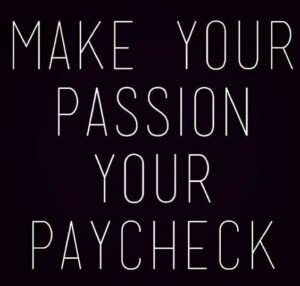
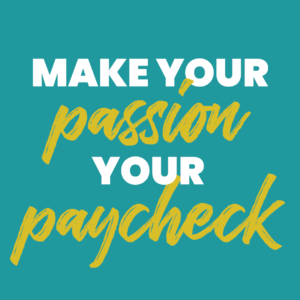
While you may not have the resources or experience with programs like InDesign or Photoshop, as we do, there are loads of great, free or low-cost sites such as Canva that you can use to create fun repurposed content that’s “on-brand”.
Another example of how we make content ‘our own’ is when repurposing newspaper or blog content. Instead of just posting a link and a brief caption we love to make it more unique and interactive. We summarise the article, ask for opinions and create an image that promotes interaction.

In this post instead of just posting the link to this blog, we made it more interactive by including reactions.
Make Your Content Go the Distance
Don’t just use your content once. When you put hours of effort into creating content [like to blog] it would be a shame and frankly a waste of time and resources to just post it once on your Facebook and be done with it.
Make sure to [if it’s relevant] to post your valuable content across all your social media platforms.
Just keep in mind every social media site has different sizing and best practices, so make sure to resize and change the look of the content to suit the platform. It may take extra time but it’s so worth it!

Don’t be afraid to repost the same content again either. It’s highly likely that the same people who were your first post won’t see or notice that you have reposted the same idea again. BUT don’t continuously repost the same post and copy time and time again. That is a sure way to lose followers. So refresh that copy and maybe even change the image and use again at a later time. For example, you can do a throwback post!
Don’t Reinvent The Wheel
As we said before, we suggest having at least 50% of your own content on your socials. But this doesn’t mean you have to recreate the wheel! Feel free to repost other people’s content and articles, just give them credit or make it your own. Don’t feel you absolutely have to have different content from your competitors, if it works it works, just listen to your audience and make sure you’re adding value.
For example, we found this great blog article/ infographic from PostBeyond called ‘ The history of Social Media’. We loved it so much and thought you guys would love it too so we decided to repost the infographic [with credit] across all our platforms from our blog, to Pinterest to Twitter!

What’s Your Audience Posting About You?
We have said this before in our blog Customer Reviews – Your Secret Marketing Fuel, but what your customers are saying and posting about you is so IMPORTANT and is an absolute goldmine when it comes to curating content.
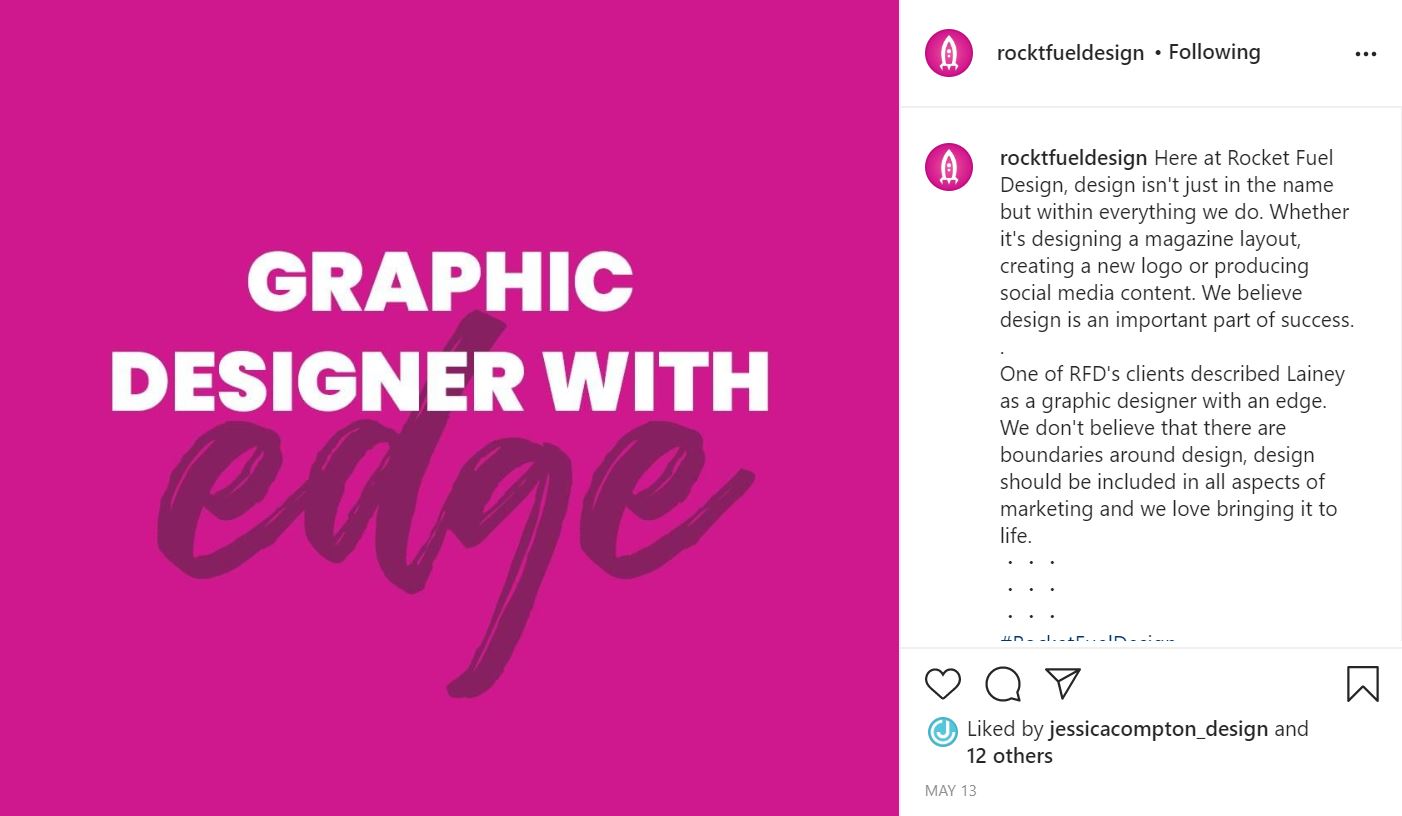
This is what we call user-generated content. Testimonials, reviews, images and a whole lot of ideas can come from interacting, listening and reusing your audience’s content.
So don’t be afraid to ask to post their content on your socials, most people are just flattered!
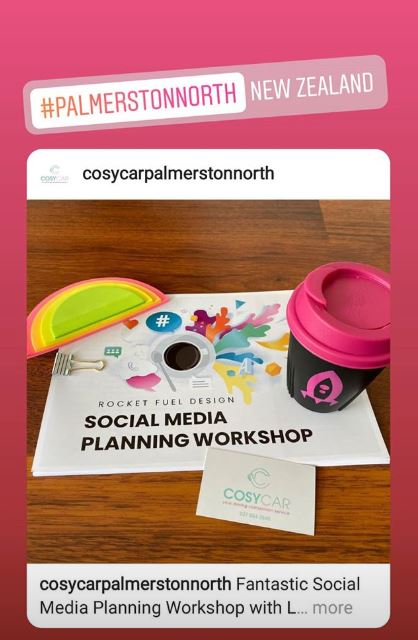
Here’s what we often say when asking to repost peoples content:
“Love your photo [say what you like about it]. We would love to repost this on our socials, with credit of course! We want to show off our [products, customers, town, local shops]”
And here’s the even better thing… You can even repost content that your business isn’t tagged in – just show off your town or the talents in your area! For many businesses who are not ‘insta’ worthy or product-centric this is a great option!
The Little Details
It’s the little and often personal details that work so well on social media, which make sense because there is social in the name, right?
Learn to feel comfortable sharing moments in the day [behind the scenes shots]. Share a post of the team’s coffee catch up, let your audience know what each team member’s day at work looks like, how your business works, share your workplace inside jokes, share your struggles, highlight a team member and why not let your audience decide on some details too!
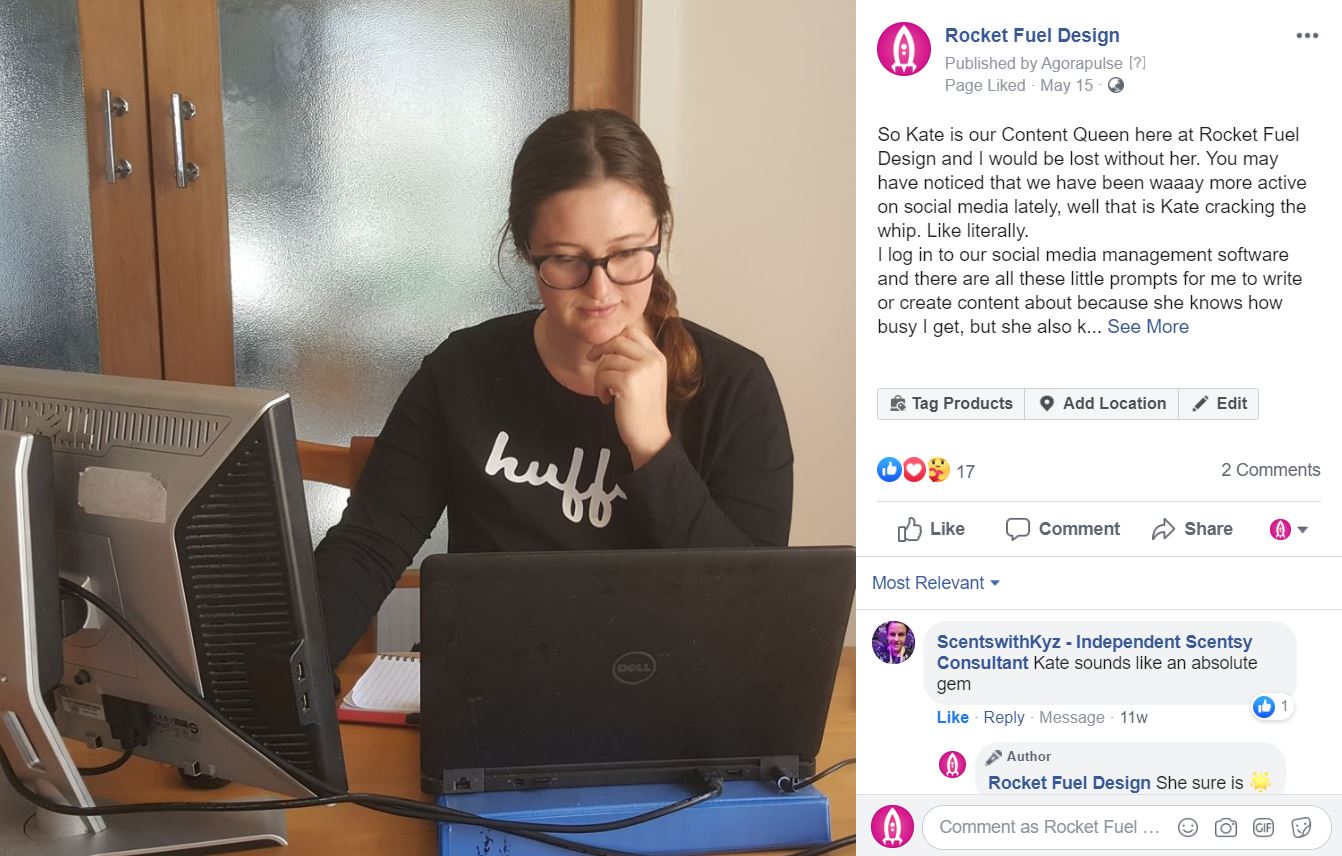 People love to be in the know and create relationships with brands, and with so many people in the same market, being personal can set you apart.
People love to be in the know and create relationships with brands, and with so many people in the same market, being personal can set you apart.
I’m absolutely guilty of watching 10-minute videos about how a chair was repurposed or watching someone on Photoshop. And apparently I’m not the only one. Why do you think Shaaanox literally gets 100,000 plus views on people watching her declutter makeup. Seriously.
You might think your everyday workday is boring and that no one would want to see it, but you would be surprised, so just try it!
If you’re scared that sharing your inner details or showing people the full process will mean they won’t buy your product and instead do it themselves. DON’T BE. Hey, some might, but most of us are L.A.Z.Y and would rather purchase it than do it ourselves…
Creating A Plan
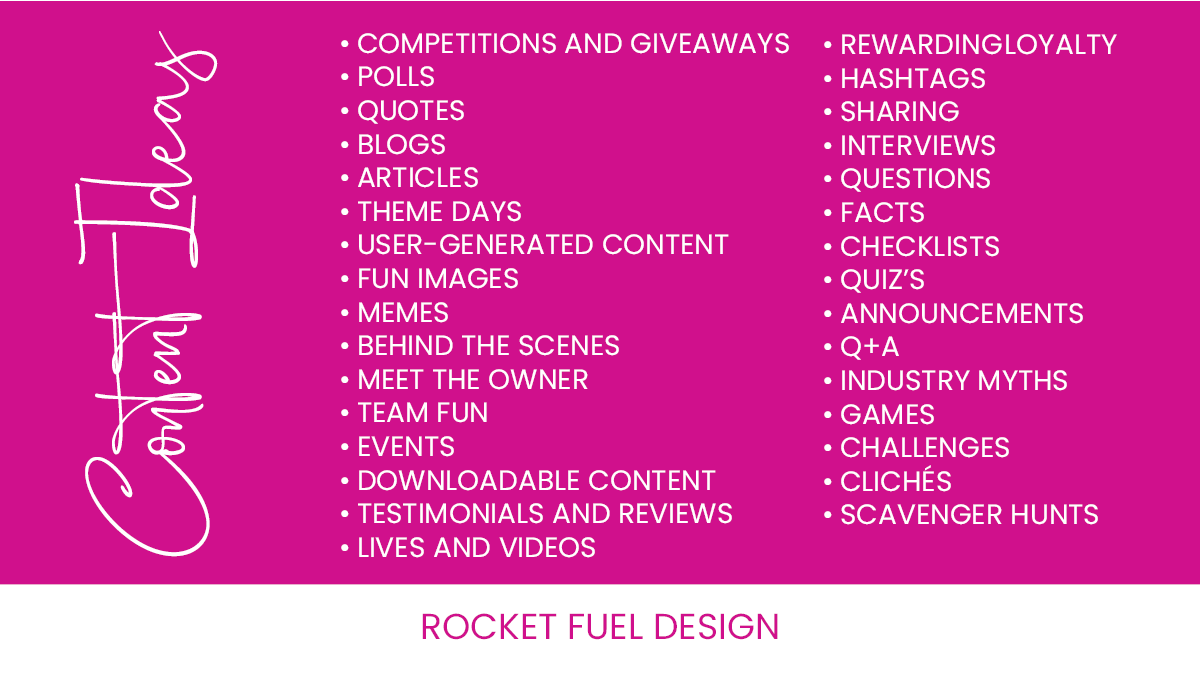
Save me to speak ideas when you are lost for content!
We highly suggest creating a calendar filling in the important dates – holidays, birthdays, promotions – and then filling your content plan out from there! And if you are still looking for ideas, save the image above so you can always have something to post about!
As we said at the start of the blog every business is different. So if you want some more information on how to curate content for your business specifically, book in a FREE no-obligation consultation with Lainey here today!
The post Guide to Curating Content for Your Social Media appeared first on Rocket Fuel Design.
]]>The post Social Media Image Sizing Guide 2020 appeared first on Rocket Fuel Design.
]]>Facebook, Instagram, LinkedIn, Twitter & Pinterest
Some might say size doesn’t matter, but it totally does, especially when it comes to social media images.
The size of your images on your social media can make a huge difference in the performance of your posts. Unfortunately, every social media platform; Facebook, Instagram, LinkedIn, Twitter and Pinterest is a wee bit different!
Sizing images wrong is one of the many common mistakes we see businesses make all the time. If there is one thing that makes us and social media managers all over the world squirm in our seats, it’s incorrectly sized images.
Today we will explore the current ‘correct sizes’ in 2020 for Facebook, Instagram, LinkedIn, Twitter and Pinterest. So here’s what Rocket Fuel Design and the social media sites themselves suggest when sizing your images:
Facebook:
Lucky and unlucky for you, Facebook has a whole range of image sizes. Which allows for a lot of flexibility when posting in the feed, but, requires you to be a bit more precise when it comes to sizing images for your profile picture and cover photo.
Profile Pictures:
Your profile picture on Facebook is one the first things people will see when they search for your business on Facebook, so making sure you display it correctly is super important.
According to Facebook, profile pictures are displayed at:
- 170 x 170 pixels on computers
- 128 x 128 pixels on smartphones
- 36 x 36 pixels on most feature phones
Don’t forget when your scrolling in your newsfeed your Facebook profile picture appears even smaller again. That’s why we suggest that you use less text-heavy profile pictures and more image-based profile pictures!
Your logo and just your logo is a great way to make sure your business looks smart and identifiable.
Here at Rocket Fuel Design, we don’t include the text – RFD – from our logo in our Facebook profile picture, why? Because on mobile it would be much too hard to see.


With the ‘RFD’ text included, you can hardly read it in any of the profile pictures. Showing the ‘RFD’ in our logo isn’t needed, since where ever our profile picture is, so our business name.
Profile pictures are cropped to a circular shape. Make sure to adjust your logo sizing to fit snuggly into the circle – there is nothing worst that an oversized logo in a profile picture.
As there is a huge variance in the sizes between devices,180 x 180 pixel images will size perfectly in every place a profile is displayed.
Cover Photos:
A cover photo should be branded and represent your business. They can promote the most important aspect of your organization – your products, services, offers, career opportunities, etc. Make sure to align the theme of your cover photo with your featured Call to Action [CTA] button.
What size should you use for your Facebook cover photo? Well, that’s a tricky one because your Facebook cover displays differently on mobile devices.
Facebook displays cover photos at:
- 820 x 312 pixels on computers
- 640 x 360 pixels on smartphones
The safe option that we recommend to fit both displays on computers and smartphones is using the dimensions 820 x 360 pixels.
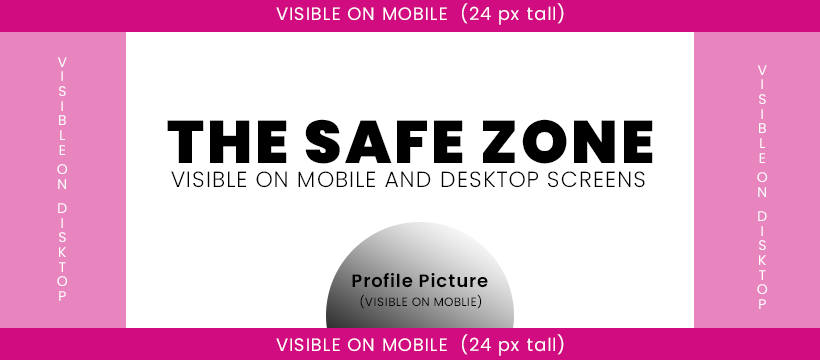
Remember that the end and tops of your images will be cropped depending on where they are being viewed. Display any important information in the safe zone.
Canva has loads of ‘Facebook Cover Temples’ if you don’t already have one.
Posts/Images:
When it comes to posting on Facebook feeds, Facebook expects all different sized images. Certain sized images are superior in Facebook feeds. Optimizing your images to Facebook’s image size guide will get the most out of your businesses posts.
For Facebook image posts, both 1200 x 900 pixels and 1080 x 1080 pixels work well in the news feed.
Linked Facebook posts need 1200 x 628 pixel images, with event images sized at 1920 x 1080 pixels.
So what about Instagram image sizing?
Instagram:
Instagram is an image-centric application, it is essential to size images correct to optimise the benefits of the social media platform.
Profile Picture:
The ideal sizing for Instagram profile photos is 180 x 180 pixels.
Make sure that your Instagram profile photo is image-heavy, not text-heavy. Because Instagram is mobile-centric your business profile will hardly ever feature on a large enough screen to see text. If you head to Rocket Fuel Designs Instagram page you will see we have used the same concept as our Facebook profile, as it is super easy to see no matter the size.
Posts/Images:
Instagram will always post your images at the best possible resolution and it automatically changes the sizing of your images to their supported aspect ratio.
To avoid cutting the most important aspects of your images, make sure to follow the rules from the start.
Sizing options for Instagram posts are:
- 1080 x 1080 pixels – Square sized posts
- 1080 x 556 pixels – Landscape sized posts
- 1080 x 1350 pixels – Portrait sized posts
Instagram Stories:
Stories are a great way to connect with your audience. 1080 x 1920 pixels is the perfect image sizing for Instagram stories and Instagram highlight covers.
To optimise Instagram highlight covers use imagery, not text and display important aspects in the centre in the middle of the page.
LinkedIn:
LinkedIn has all sorts of funny sizing when it comes to images. Because LinkedIn is a business-focused application, it is super important to have a professional-looking page.
You wouldn’t have terrible sized images on your website so why would you on LinkedIn?
LinkedIn Page Sizing:
- 300 x 300 pixels – Logo image
- 1536 x 768 pixels – Cover image
- 1128 x 376 pixels – Main image
- 502 x 282 pixels – Custom modules
- 900 x 600 pixels – Company photo
By now we trust you understand that text-heavy profile photos are a no-no.

Kate’s Profile image on LinkedIn isn’t too text-heavy and the most important text is large and bold so it’s easy to read.

See how the same concept doesn’t work with Rocket Fuel Design’s business cover photo. The top of the rocket is cut off and the text feels like it doesn’t have space.
Seeing that your LinkedIn cover and image sizes are skinny it’s important to ensure that you only have the most important information conveyed via text. So what image sizes are ideal for LinkedIn post images?
LinkedIn Post Photos Sizes:
- 1200 x 628 pixels – Link Images
- 1200 x 628 pixels – Linked Post
- 1200 x 628 pixels – Moblie Image Post
- 1200 x 900 pixels – Desktop Image Post
And last but not least, Twitter.
Twitter:
Even though Twitter seemingly is all about the talk, research shows that tweets with images get 150% more retweets than tweets without images. So you better get it right!
Here’s what Twitter suggest when it comes to sizing images for profiles, headers and images:
- 400 x 400 pixels – Profile Images
- 500 x 500 pixels – Header Image [60 pixels on the top and bottom could be cropped].
- 520 x 254 pixels – Shared Link
- 1024 x 254 pixels – Shared images [the image is reduced to 440 x 220 pixels when in the timeline so make sure to have any important information centred in the middle].
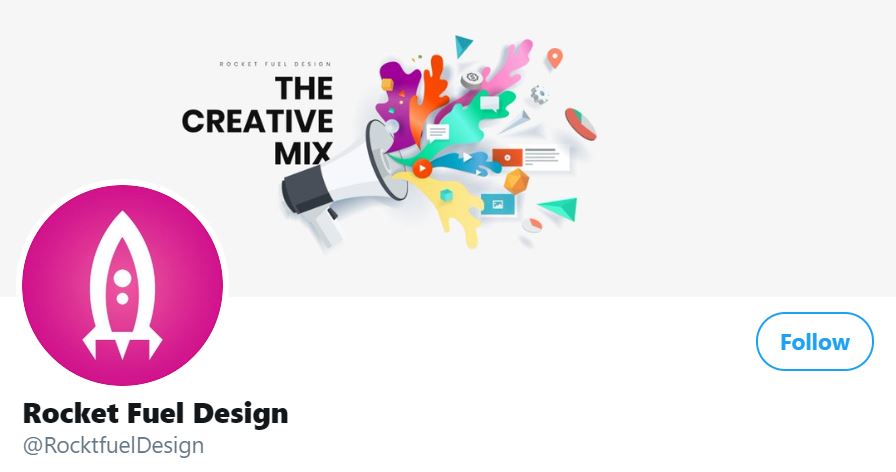
We are using our own Twitter account as an example of what not to do with your header photos! In general, the text is not big enough to see easily, our brand name is tinier yet [even with my glasses on I’m squinting]. So keep this in mind sizing when designing your cover picture!
Pinterest:
Pinterest is another image-based application and because multiple images displayed all at once, the quality and sizing of your images are so, so important!
It is suggested by Pinterest to ‘pin’ images that are compelling and tell a story, this will increase the likely hood of someone clicking on your post and make them want to learn more. Use images that have context and bring your topic to life, including important text/copy over your images can help to do this.
Your brand should be the focal point, so make sure to include your logo [avoid placing your logo in the lower right corner]!
Pinterest Photos Sizes:
Something different about Pinterest is that it asks you to think vertical, so pinning a Facebook size image here would look bad and will most likely be cut down to fit in the feed. Pinterest recommends using a 2:3 aspect ratio for pins, so intend to create pins where your image’s width is ⅔ its height.
Here are some example of sizes you can use for your pins:
- 600 x 900 pixels
- 1000 x 1500 pixels
- 1200 x 1800 pixels
- 2000 x 3000 pixels
Square sized images 180 x 180 pixels can also be used, but they may not perform as well. You can also extend the length of your Pins, to make them as tall as you like, but be aware they will be cropped in the feed.
Pinterest Video Sizes:
For videos, it is suggested to use either vertical or square sizing. For best results pin video’s that teaches how to do something and that is around 6-15 seconds of length. Instead of relying on audio use text overlays of captions to describe your video as most people scroll through Pinterest without sound on.
- 1920 x 1080 pixels – Vertical
- 280 x 720 pixels – Vertical
- 180 x 180 pixels – Square
- MOV or MP4 – Files
- Up To 2GB – File Size
- 5 minutes – Max Length
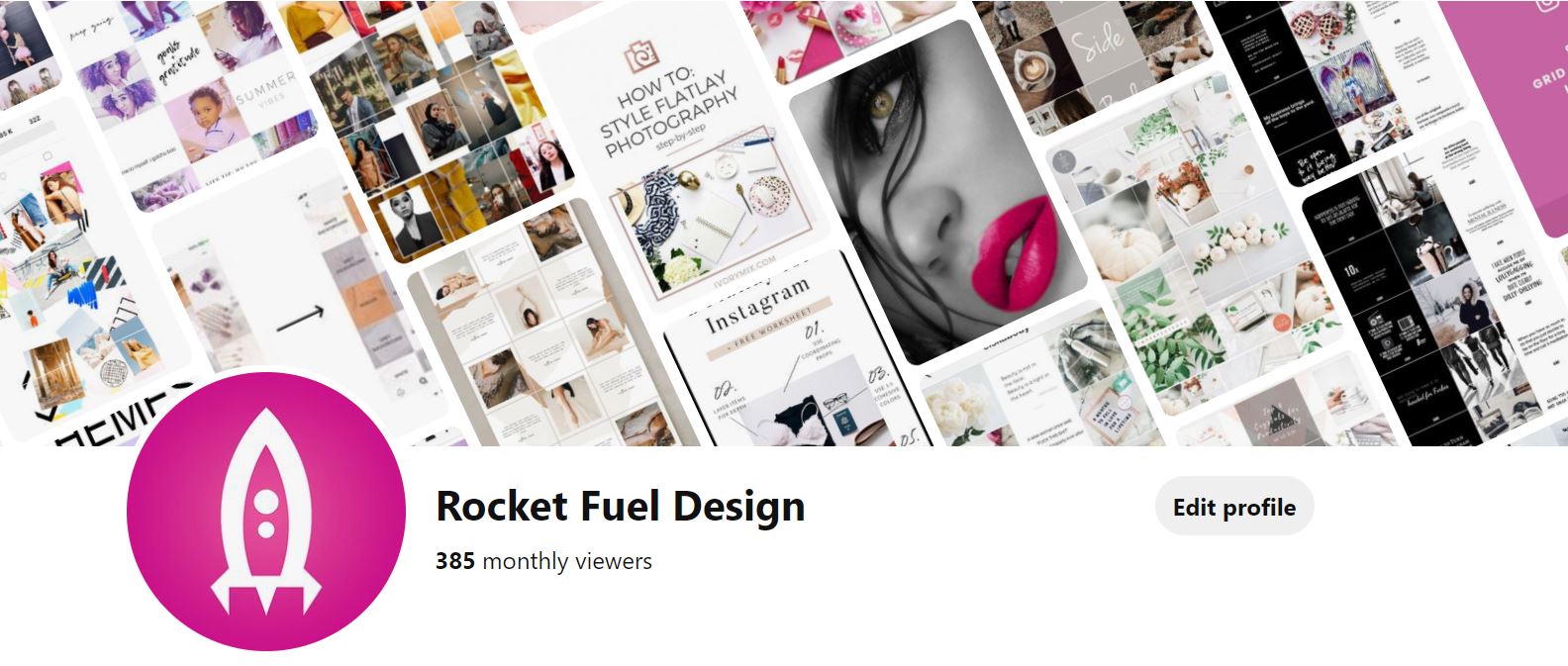
Pinterest Profile Sizes:
- 180 x 180 pixels Minimum – Profile Picture
- 340 x 3 40 pixels – Board Cover
And as we have said throughout – don’t go too text-heavy on profile and cover board images. It is important to be able to see text and images clearly on desktop and mobile devices.
Understanding and posting content in all the different social media sites can be a long and tedious task. But it does make a massive difference to the performance of your posts. Hopefully, we have helped you to understand the difference images sizes to the best preform on; Facebook, Instagram, LinkedIn, Twitter and Pinterest.
Keep in mind social media platforms are updating and changing their best practises around images all the time. So make sure to check up on each social media applications recommended sizes often and update your profile, cover and post sizes when they do!
Sometimes when it comes to crucial parts of your businesses social media pages, it’s best to leave it to someone with a good eye.
We would love to help in the process of creating your businesses social media cover designs and more.Let us know below if you found this information useful.
The post Social Media Image Sizing Guide 2020 appeared first on Rocket Fuel Design.
]]>The post 5 things I learnt about marketing that every business owner needs to know. appeared first on Rocket Fuel Design.
]]>Every business needs to understand the 5 main areas of marketing to truly become successful.
Marketing can be a daunting subject for anyone to understand, let alone a new business owner. With so many areas to cover and an ever-changing environment, it can be tough to know where to begin. To help new, and existing, business owners understand the main themes that they need to know to use marketing successfully I have compiled a simple blog explaining the “5 things I learnt about marketing that every business owner needs to know.” Many of these areas were learnt at business school and with the help of amazing online resources each of these 5 things are explained, simply, below for ease of developing an understanding of marketing, to aid your business’s success.
1. Understand the 6 main types of business marketing
-
-
Direct Response Marketing
-
Direct response marketing is described by Smarty Ads as a sales technique designed to evoke an on-the-spot response and encourage a prospective customer to take action by opting into the advertiser’s offer. Unlike other marketing types, the direct response method requires very minimal waiting time to see measurable results. Marketers are able to view performance from the moment the campaign is launched.
-
-
Inbound Marketing
-
Marketo describes Inbound marketing is a strategy that utilizes many forms of pull marketing such as content marketing, blogs, events, SEO, social media and more. This is to create brand awareness and help to attract new consumers. This is in contrast to outbound marketing, where marketers attempt to find customers, inbound marketing gains the attention of consumers and makes the business easy to be located.
-
-
Outbound Marketing
-
As described by Wordstream, outbound marketing refers to any kind of marketing where a business initiates the conversation and sends its message out to consumers. Examples of this include more traditional forms of marketing and advertising such as TV commercials, radio ads, print advertisements, outbound sales calls (AKA “cold calls”), and email spam.
-
-
Content Marketing
-
Content marketing is a strategic marketing approach focused on developing and providing useful, relevant, and consistent content to attract and retain a clear segment of consumers and, ultimately, to drive profitable consumer actions.
-
-
Pay-Per-Click Marketing
-
As explained by Search Engine Journal, pay-per-click marketing (PPC) is an advertising technique that lets marketers place ads on an ad platform and pay the host of that platform every time their ad is clicked. The goal of a PPC ad is to lead the person viewing it to click through to the advertiser’s website or app, where that visitor can complete an action, such as purchasing a product.
-
-
Social Media Marketing
-
Social media marketing is simply described by Neil Patel as the process of creating content that you have tailored to the context of each individual social media platform in order to drive user engagement and sharing.
2. Understand Target Markets and Buyer Personas
-
-
Target market
-
A target market is a group of consumers or organizations most inclined to purchase a business’s products or services. As those consumers are likely to want or need a company’s offerings, it makes the most sense for the business to focus its marketing efforts on reaching them. Marketing to these buyers is the most effective and efficient approach.
-
-
Buyer persona
-
A buyer persona is, according to HubSpot, a semi-fictional representation of your ideal customer. It’s based on market research, actual data about your existing customers, and a few educated assumptions. It helps you to understand and relate to an audience that you want to market your products and services to. Buyer personas are situated at the heart of any marketing strategy, and throughout every part of the Inbound process.

Hit your target market!
3. Develop Marketing Budgets
Allocating funds for a marketing plan is daunting, but it’s essential for a business’s success. Below are the 6 steps, as devised by OutBound Engine, that you need to understand in order to create a successful marketing budget for your business.
- Step 1: Look at the Big Picture
- Step 2: Outline Your Sales Funnel
- Step 3: List Your Operational Costs
- Step 4: Set Goals
- Step 5: Scope Out the Competition
Sales Funnel
4. Utilise Visuals and Branding
Visual marketing is the technique of using photos, graphics, videos, and other visual content to market a product or service. Businesses in every industry can benefit from using visual content in their marketing. Using visual branding, such as images, graphics, videos, across your marketing helps consumers remember information about your brand. Below are some statistics from Tinuiti that show just how powerful visual marketing can be:
- When consumers process information paired with relevant images, they retain 65% of that information three days later.
- 93% of human communication is visual.
- People are 80% more likely to read content if it’s paired with colourful visuals.
- Visual content is 40x more likely to be shared across social media.
- Presentations with visual aides are 43% more persuasive.
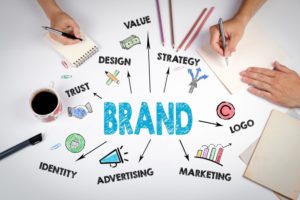
Utilize your branding!
5. Retention Matters
The customer retention definition in marketing is “the process of engaging existing customers to continue buying products or services from your business.” as defined by CrazyEgg. The best customer retention techniques allow you to build long relationships with consumers who will essentially become loyal to your brand. This could lead to them spreading the word of your brand to their peers, which can turn them into brand ambassadors. It is easier and less expensive to retain customers than to acquire them, making this an important marketing tool. The most recent statistics indicate that you’ll spend five times less money on customer retention than you will on acquiring new consumers.
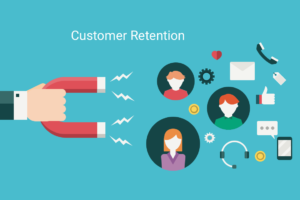
If you understand and use these 5 marketing areas it is likely to aid the success of your business. Check out our other blog posts for more ideas and information on how to help your brand!
And as always, if you have any questions, pop them in the comments below for the team to answer!
The post 5 things I learnt about marketing that every business owner needs to know. appeared first on Rocket Fuel Design.
]]>The post My Graduation appeared first on Rocket Fuel Design.
]]>Last week’s blog by Bella, made me reminisce about my not so smooth process of coming to study at Massey University. It also reminded me of and my looming non-existent graduation.
Some people go to university to party, some go to get away from their parents, others go because that’s just what you do! I guess the latter is what happened to me, although it didn’t happen automatically.
When I first graduated from high school, one of the youngest in my year, I had the dream that I was going to join the New Zealand Broadcasting School. That didn’t happen.
After one terrible interview that I travelled 5 hours for, I clearly wasn’t prepared. I literally forgot the name to my favourite movie: ‘The Help’. To make matters worst, while trying to remember the title, I quoted perhaps the most inappropriate and hell, the best part of The Help, “eat my shit”. How’s that for interviewing skills!

I was pretty adamant that I wasn’t going to get to NZBS after that and I guess my gut was right. It was humiliating, my first failure. I had told everyone that I was going to do this and had all my sights set on it. Looking back the rejection was one of the best things to happen to me.
2016 Was Not My Year
Instead of giving up straight away [like I should have] and starting a new dream, I stupidly decided to try again next year. So to fill in my time for my next try at NZBS, I decided I was going to work at my home and then do Camp America.
Within a week of the first job, I managed to pull all the ligaments in my ankle while trying to ride a sheep. Yes, I realise how very ‘New Zealander’ that makes me sound. So yet again my dreams were ruined, stupid sheep. 2016 was not my year.
Instead, I worked in a small local cafe, barristering and waiting tables for the rest of the year. During this time I felt the harsh eyes of old teachers and pupils, who obviously thought ‘is that all your doing with yourself?’. In that cafe, I worked harder than I ever did during university or now [sorry Lainey].
I wouldn’t trade that year for anything, I learnt what it was like to do hard work, work long hours for average pay, to commit to something and it helped me to see the true benefit of upskilling. I grew up hugely.
The second interview with NZBS was another flop, as I failed to prepare yet again. But this time plan B worked out, I got accepted to Massey’s Bachelor of Communications.

My Graduation
Compared to the one short year of commitment to NZBS, graduating from Massey University seemed light-years away. After three short years, and six months of re-employment reality, here we are, graduation day.
Unfortunately, I may never get to graduate traditionally, thanks COVID-19. But as my past shows, failures, plans changing and sheep riding, lead to weird and wonderful things, you’ve just got to trust in the process.
My graduation wasn’t what I expected. So instead of using my three years of study to walk across a stage and shake hands with a stranger, I’m using it to badly photoshop myself into a graduation gown. Now that’s a true reflection of my achievement, right?
Happy Graduation to all my fellow class mates and thank you to all my family, friends, lecatures and businesses like Rocket Fuel Design for all your engcoursgement and knowledge thoughout the years – Kate x
The post My Graduation appeared first on Rocket Fuel Design.
]]>The post Social Media Marketing As My Future Career appeared first on Rocket Fuel Design.
]]>As a child, I was no different from others in wanting to be a vet or something that is WAY harder than you believe as a child. I then spent most of my teenage years set on being an Interior Designer, that did not pan out the way I always dreamt of. Now here I am, my 3rd year out of high school with the intention of becoming a Social Media Marketer. This is the story of how I arrived here.
My university experience has been anything but straight forward, through this experience I have learnt many things, positive and negative. But I am coming into my last year with knowledge, strength and durability because of it.
I began my University experience at Victoria University of Wellington studying a Bachelor of Design, I had moved from Palmerston North to Wellington to pursue this degree as it is not available at Massey University in Palmerston North. The move was a big deal for me as I had resided in Palmerston North with my immediate family my entire life, that in itself was a huge learning curve.
My First Year At University
A Bachelor of Design at Victoria University of Wellington requires you do 4 compulsory first-year papers before you can move on and specialise in your second year.
These papers, in summary, were drawing, graphic design, the theory of design and hard materials design. The only paper that I had a good grasp on before studying was the theory paper as that was the area I wanted to specialise in. I felt that I was not going to be creative enough to pass the other courses. To my surprise I quickly realised I was far more creative then I originally believed.
I suspect the many years of structured NCEA courses gave me very little free reign in being creative and now I had the opportunity to be as creative as I wished and created all that I wished.
Practically, I learnt how to use various Adobe software’s different drawings techniques and how to operate skill saws and various other machinery that you would find in a wood workshop. I also learnt how to confidently and successfully present my design work to a small group and lecturers, this was extremely intimidating for me as I have always struggled with confidence and having something I created be critiqued in front of my peers was something of a nightmare to me.
I knew that I had to present to pass so it was just another learning curve I had to face and with each presentation, I gained confidence.
Moving Home
At the end of 2018, I decided that I much preferred Palmerston North as a place to live whilst studying and also decided that I did not want to pursue design as a career but rather as a hobby. I had been doing a few different business papers at Victoria University of Wellington, including marketing. I decided that a Bachelor of Business majoring in Marketing was a more viable and enjoyable career option for me, an option that still gives me the opportunity to be creative as well as academic in my work.
Looking back I believe the main things I learnt outside of my discipline were about myself. I learnt that I could do anything I put my mind to and no one was actually there to judge me as I believed. I also learnt that the world is a lot bigger and a lot scarier than you imagine it to be whilst you are in the education system where you, often, do not have a chance to think or act for yourself but also that we are capable of fitting into that world with just a little push and determination.
Lastly, I learnt that Palmerston North is not as bad as I once thought it to be in high school, it is actually remarkably tranquil and I’m glad about the decision I made to come back.
Back To Business
Going into my second year at Massey University in Palmerston North was again a big learning curve as I had to navigate a completely different University whilst studying a different degree.
As I began studying business I struggled with the fact that I had changed degrees from something so full of practical assessments and creativity back to rigid compulsory business papers that I had no interest in whatsoever. These included finance, accounting and economics which I initially believed I would struggle with as I had not done maths or anything of the sort for about 3 years, but I once again proved to myself that I am more capable than I originally thought.
Although I had to complete these papers I also began my second year marketing papers which were all around different areas of marketing, such as marketing research, social media marketing and consumer behaviour, which helped me to decide what I was wanting to specialise in.
I ended up learning a lot over this year in terms of disciplines as I was doing such a wide variety of papers, copious things that I have already abandoned but also copious things that interested me and stuck in my mind. Along with disciplinary learning, the main thing that unearthed and learnt was what I wanted to pursue as a career in a more specialised minor, which is Social Media Marketing.
Why I Made My Decision
I chose Social Media Marketing because of the modern, creative and open discipline it is. It gives me the opportunity to be creative and expressive whilst also providing a stable and intellectual element, the best of both worlds. Along with that, I also grew up with social media and it’s development into the platforms we know and trust today such as Facebook, Instagram and Twitter. I have seen them evolve into the perfect marketing tools that they now exist as and can not what to see how they even further develop.
All of the various changes for me were stressful and at times a nuisance as I have always been organised and rigid in my routine and plans, but it definitely taught me to be more flexible and understanding of myself. Thankfully for me many of my first-year design courses transferred over to Massey as electives so that, with the help of a summer paper, I was not put any time behind my original graduation point. All in all, I learnt equally as much in terms of disciplinary knowledge as I did about myself, my needs, my wants and my future path.
Choosing My Internship
I chose to do an internship through Massey University as it was far too valuable of an opportunity to pass up. Getting my foot in the door and experiencing a professional environment will give me that little push I need to enter the corporate environment myself after my studies. Being able to gain professional experience in the area of expertise I want to explore is an opportunity to figure out if Marketing is something I want to do in the long haul, and if so gives me the tools to be able to enter a job and know more about this area, practically, than other graduates.
Along with giving me a boost on my CV I know that I will also gain experience and skills in many areas as Rocket Fuel Design, involves itself in many different areas of expertise, such as design, marketing, photography, website creation, etc.
Rocket Fuel Design was the organisation that I wanted to do my internship with as all of these areas are of great interest to me and most of these areas I have knowledge in that I would like to further expand.
Lainey is the most amazing “host” I could have asked for and her story of starting Rocket Fuel Design is as inspiring as it gets. I hope that one day, as my story continues, I too will be able to help and inspire.

The post Social Media Marketing As My Future Career appeared first on Rocket Fuel Design.
]]>The post Why You Should Stop Boosting Your Facebook Posts appeared first on Rocket Fuel Design.
]]>Sometimes we just want it easy, but in this case, we suggest you don’t! When you spend any money on advertising you want to see results. Boosting Facebook posts may seem like its creating effect, but they do not create tangible results!
What happens when you boost a post?
When you boost on Facebook it optimizes the post for more engagement – likes, shares, comments etc.
This is true even if you post a link, rather than enhancing the number of link clicks, a boosted post will still optimize for engagement. Meaning you may see lots of engagement but not many clicks through to your shared link.
When it comes to targeting with a boosted Facebook post you have three options; people who like your page, people who like your page and their Facebook friends, or targeted audience of your choice.
Negatives of Boosting
If you don’t already have a high volume of page likes who are your target audience, you will be wasting a proportion of your money.
Most people have hundreds of Facebook friends, making it hard for Facebook to ‘pick out’ who is the most relevant within their list.
And while you can ‘target’ an audience, the ability to narrow target audiences down is very limited. Targeted boosted posts won’t allow you to choose on behaviours or include/exclude your current fans or custom target audiences.
Not only can’t you target down enough, but you will also find you have no real control over the placements of your boosted ads – on desktops or mobiles feeds.
The placement of your advert matters because there are certain things that people prefer to do on desktops rather than mobile. So if your post is asking people to do an action [which they always should] you need to think about what device will get more action.
No matter how you chose to ‘target’ on boosted Facebook posts you are bound to lose money somewhere, as they are just not specific enough.
What you should do instead?
Just do it better!
Simple, use Facebook Ad Manager instead.
It may take longer to get your head around and build, but you will find that you can target a more relevant audience, create a more suitable campaign objective and have more control over when your ads are seen.
Vanity metrics, as we like to call them, i.e engagement, shouldn’t be the end goal of any campaign. You want your audience to take action, true action, because while a like or comment makes us feel and think we look good it doesn’t move the needle for your business. The end goal is – getting your audience to visit your website, sign up or register [so you can market further] or buy your product/service.
Overall while you may have to take extra steps, you will get the true value out of your money if you use Facebook Ad Manager instead of boosting your posts.
How to use Facebook Ad Manager?
Here are some simple steps on how to use the Facebook Ad Manager to promote your posts.
- Click the green ‘Create’ button in Facebook Ad Manager
- Select your objective – brand awareness or engagement
- Reach your customer target audience by choosing your targeting parameters.
- Designate a pre-existing post through the drop-down menu
- Launch the campaign
Once you have the basics of Facebook Ads Manager down you can move into other more sophisticated campaigns AND THAT is where things start to get really exciting!
Creating an advertisement on Facebook is more time consuming, but we believe it is worth it. It is more cost-effective and creates better results.
If Facebook advertisements feel a bit scary to you, we are happy to set them up for your business.
Talk to us today to see how we can help manage your social media.
The post Why You Should Stop Boosting Your Facebook Posts appeared first on Rocket Fuel Design.
]]>


